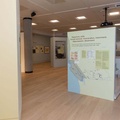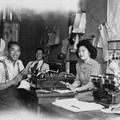If there’s one thing we have a lot of here at the Nikkei National Museum (NNM), it’s photographs—we are always sifting through our database, scanning more images, and taking in new donations and loans from different families. That isn’t to say we don’t also have a lot of fascinating artefacts—from old dresses and uniforms to musical instruments, tools, and even swords—as well as artwork, books, and documents, though for me, the photographs feel like the heart of the collection. They’re usually the thing that ends up telling me the most when I’m doing research, and often spark questions that continue to feed my curiosity about the history of our community. A picture can tell you a lot, as the old saying alludes to; it can also both tell and not tell something—it can hint at a possibility without stating something outright. Quite often these possibilities are things we never would have considered before seeing the photograph.
The picture accompanying this story was shown to me by Mary Ohara. I went to visit her one day in June to ask her about picture brides—since Mary is a nisei, I thought she might have gotten to know some of the issei picture brides of her mother’s generation. Mary confirmed my sense that “there were a lot of picture brides in my mother’s day.” Though she knew this to be true in a general sense, she didn’t learn many personal details from the issei, saying “unfortunately, they didn’t talk too much [about] their life and all that.”
Mary’s mother was not a picture bride herself, though her parents were married in a way that wasn’t much different from most picture bride marriages. The bride and groom were cousins, and the bride’s father was already living in Canada. “It was a paper marriage, a certificate marriage in Japan.” Mary explained: her parents each registered their marriage on paper from their respective continents, and Mary’s mother then joined her father in Canada as his wife. This was normal in those days: combining the traditional Japanese practice of arranging marriages with some logistical accommodation and legal issues associated with the groom being in Canada. The only thing special about picture brides, says Mary, was the picture: “In those days, there were hardly any pictures taken.”
Most people today think nothing of having their photograph taken or even taking one of themselves, with some people taking photographs of themselves daily. We see photographs everywhere in newspapers, magazines, advertisements, and throughout the internet. Talking to Mary reminded me that just seeing a photograph would have been a special occasion in the picture bride era.
To make the best possible impression on prospective grooms, picture bride photographs were formal studio portraits of the prospective brides, where they wore their best kimonos with immaculately arranged hair. Most of the portraits look rather solemn, though I think in many a glint of hope and adventure is apparent. Today, few of these photographs remain: after all, many of them would be over a hundred years old.
Mary had her photo album ready to show me when I went to visit her, wanting to show me a picture, not of a picture bride, but of a bride of Mary’s generation. That photograph turned out to be Lil (Lily) Shishido, whom Mary knew, and who was married in Lemon Creek.
The Shishido family was one of the few in Lemon Creek that were allowed to own a camera to capture special moments like this one. Mary remembers that her own family’s camera was confiscated when they were ordered to live in Hastings Park.
The Shishidos had special privileges because the father, Masajiro, was a veteran of the First World War. He was a member of the famous Fighting Tenth Battalion that was a key part of the force that took Vimy Ridge. Lil’s father was wounded in a subsequent battle with shrapnel in his right shoulder and chest, and he never recovered the use of his right arm. He re-established himself after his discharge from the army by working as a barber on Powell Street in Vancouver.
In addition to their camera, Mary recalls that the Shishidos also had a record player and albums of Japanese and English-language music. Mary was friends with Lil and her younger sister, the latter who taught Mary how to jitterbug. The three of them would all go to the Lemon Creek dances, and it was there that Lil met and fell in love with her husband. According to Mary, Lil was a good-looking woman with plenty of admirers, and she chose the one she loved and had a beautiful wedding in the midst of internment.
In the NNM database, this photo is titled “Lily Shishido About to Enter a Car On Her Wedding Day.” It is described as follows: “The image shows a bride about to get into a car and there is a woman holding her long veil off the ground. The bride is Lily Shishido.” I think the photo says much more than that. This is a portrait of a nisei bride, who was able to marry a man she fell in love with at a dance, even if the dance was in an internment camp. Lil was more fortunate than many others of her generation: Mary remembers admiring the fashions of the older girls at Lemon Creek, and Lil was the only bride that Mary recalled wearing a white wedding dress. I feel, in this photo, that she represents the joys and hopes of the young people in the camps: she’s stepping into a car, and it’s as if she might be going anywhere.
After they were married, Lil and her husband moved to Toronto, while Mary went with her family to Japan in 1946. They corresponded, and Lil sent Mary some of her old clothing, as well as sugar, which was heavily rationed in post-war Japan.
When asked about picture brides, some seventy-odd years later, Mary thinks first of the picture of Lily Shishido. This picture represents a sequel to the story of picture brides: the new bride embodies both a continuation and reiteration of the hopes of the picture brides and other issei women who joined their husbands in Canada. The sequel is that this new bride is in love with her husband, and she can enjoy a romantic wedding in a beautiful white dress, an experience that any picture bride might have hoped for, for herself and her daughter. And yet, like the picture brides of the past, the bride in this photo, Lily, is preparing for a journey, stepping into a vehicle that will take her to an unfamiliar place where she will build a new life.
*This article was originally published in Nikkei Image, Summer 2016, Volume 21, No. 2.
© 2016 Carolyn Nakagawa; Nikkei National Museum & Cultural Centre






